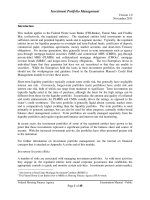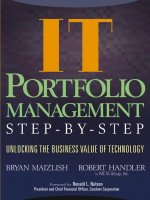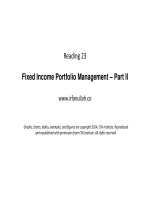R24 equity portfolio management
Bạn đang xem bản rút gọn của tài liệu. Xem và tải ngay bản đầy đủ của tài liệu tại đây (1.62 MB, 79 trang )
Reading 24
Equity Portfolio Management
www.irfanullah.co
Graphs, charts, tables, examples, and figures are copyright 2014, CFA Institute. Reproduced
and republished with permission from CFA Institute. All rights reserved.
Contents – Equity Portfolio Management
1.
2.
3.
4.
5.
6.
7.
8.
Introduction
The Role of the Equity Portfolio
Approaches to Equity Investing
Passive Equity Investing
Active Equity Investing
Semi-Active Equity Investing
Managing a Portfolio of Managers
Identifying Selecting and Contracting with Equity Portfolio
Mangers
9. Structuring Equity Research and Security Selection
www.irfanullah.co
2
2. The Role of the Equity Portfolio
• Equity represents a significant source of wealth
• Equity can be found in both individual and institutional portfolios
• Investing across multiple markets offers diversification benefits
• Equities offer superior protection against unanticipated inflation
• High historical long term rates of return
www.irfanullah.co
3
3. Approaches to Equity Investment
• Passive Management
– Investor does not attempt to reflect his investment expectations through
changes in security holding
– Equity market is efficient indexing is the best strategy
– Not really passive because portfolio needs to change when index is
reconstituted or when weight of a stock changes because of corporate
action
• Active Management
– Outperform benchmark portfolio by investing in underpriced securities
– Dominant management style
www.irfanullah.co
4
3. Approaches to Equity Investment
• Semiactive Management
– Also called enhanced indexing or risk-controlled active management
– Variant of active management
– Outperform benchmark but keep tracking risk in control
www.irfanullah.co
5
4. Passive Equity Investing
According to William Sharpe:
4.1 Equity Indices
4.2 Passive Investment Vehicles
www.irfanullah.co
6
4.1 Equity Indices
Stock index’s characteristics are determined by
1.
2.
3.
4.
Boundaries of stock index’s universe
Criteria for inclusion
How stocks are weighted
How returns are calculated
Listen to this lecture if you need a refresher on security market indices…
/>
www.irfanullah.co
7
The S&P 500 also seeks to make sure the industry sectors in the S&P 500 represent the
industries in the economy. The sector percentages in the S&P 500 in 2010 were:
Information Technology (17.8%), Financial (15.1%), Energy (12.7%), Industrials (11.3%),
Consumer Staples (10.6%), Consumer Discretionary (10.6%), Materials (3.7%), Utilities
(3.4%), Telecom Services (3.1%). (Source: S&P 500 Factsheet)
To be included in the S&P 500, a company must meet the following minimum criteria:
Be a U.S. company.
Have a market cap of at least $4 billion.
At least 50% of its stock must be held by the public.
Four consecutive quarters of positive earnings.
A stock price of at least $1 per share.
Contribute to the overall balance of sectors within the S&P 500, to help it represent the overall
market sector make-up.
Be listed on either the New York Stock Exchange or the NASDAQ. Real Estate Investment
Trusts (REITs) and business development companies can also be included.
The top 10 largest companies in the S&P 500 in 2011 were: Exxon Mobil, Apple, IBM,
Chevron, General Electric, Microsoft, AT&T, Johnson & Johnson, Procter & Gamble and Pfizer.
The market cap of these 10 companies represent 20% of the market cap of the total S&P 500.
/>www.irfanullah.co
8
Price Weighted
Value Weighted
Each stock weighted
Each stock weighted
according to absolute share according to market cap
price
Float-weighted
Biased towards highest
price share
Biased towards high
market-cap stocks large
Effectively investing in
companies, overvalued
proportion to share price
stocks
Simple to construct
DJIA is the most prominent
example
Suggestion: adjust
component weights based
on fundamentals (such as
P/E)
www.irfanullah.co
Equal Weighted
All stocks treated the
same
Small company bias
because such indices
include many more small
companies
Requires frequent
rebalancing
9
www.irfanullah.co
10
Price Weighted
www.irfanullah.co
11
Value Weighted
www.irfanullah.co
12
Float Weighted
www.irfanullah.co
13
Equal Weighted
www.irfanullah.co
14
www.irfanullah.co
15
www.irfanullah.co
16
www.irfanullah.co
17
4.2 Passive Investment Vehicles
Refresher on swaps…
/>
www.irfanullah.co
18
Indexed Portfolios
www.irfanullah.co
19
Conventional (Open End) Index Mutual
Funds
Exchange Traded Funds
Buy/sell shares at market close NAV
Buy/sell any time during trading day
Shareholder accounting at the fund level can
be a significant expense
No fund level shareholder accounting
Low index license fees
Higher index license fees
Less tax efficient (selling shares capital
gains taxes)
Tax efficient due to in-kind redemption
process (fewer taxable events)
Cost associated with providing liquidity to
shareholders who are selling fund shares
Transaction costs for those buying/selling ETF
but those holding shares have protection
Can NOT short
Short trades allowed
www.irfanullah.co
20
Indexed institutional portfolios could be managed as separate or pooled accounts
Pooling means having multiple portfolios under the same management (cost effective but
performance management is more difficult)
Indexed institutional portfolios have very low cost compared to both conventional index mutual
funds and exchange traded funds
www.irfanullah.co
21
How do we create an index portfolio? Do we replicate the entire index?
If index has less than 1000 stocks which are liquid Full Replication
Otherwise use stratified sampling or optimization
Full replication is common for indices like S&P 500. Why?
Index return – portfolio return = sum of:
www.irfanullah.co
22
Stratified Sampling: Allows manager to build a portfolio that retains the basic
characteristics of the index without having to buy all stocks in the index
Small Cap
Define multiple dimensions
Identify weights for each cell
Mid Cap
Large Cap
Industry A
Industry B
Randomly select/sample
Industry C
Include based on weights
Lower cost but higher tracking
error compared to full replication
Industry D
More dimensions and finer divisions closer replication
www.irfanullah.co
23
Optimization is a mathematical approach to index fund creation involving the use of:
Optimization
Stratified Sampling
Takes into account covariances among factors
used to explain returns on stocks
Simplistically assumes factors are uncorrelated
Even the best models are likely to be imperfectly
specified
Even in the absence of index changes this method
requires periodic trading to keep risk of portfolio
aligned with risks of index
Predicted tracking error is often understated
www.irfanullah.co
Results compare well with those of optimization
24
www.irfanullah.co
25









